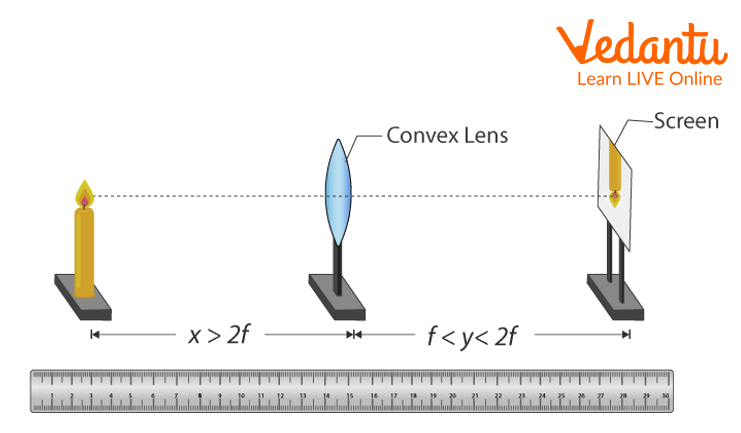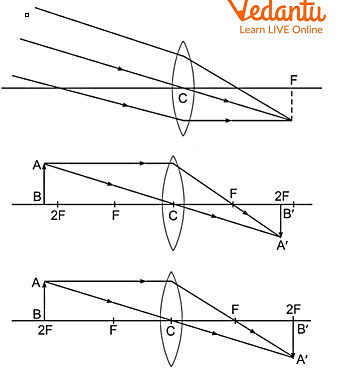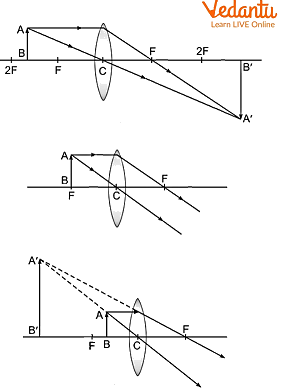




An Overview of Class 10 Physics Lab Manual To Find Image Distance For Varying Object Distances Of A Convex Lens With Ray Diagrams
Physics Experiment- To Find Image Distance For Varying Object Distances of a Convex Lens With Ray Diagrams - Introduction
A transparent material is bound by two surfaces to form the lens. It has an optical centre, an aperture, a principal axis, a principal focus, and a lens's centre of curvature. There are two different kinds of lenses: convex lenses and concave lenses. These lenses can produce real or virtual images, depending on the user. In this article, we will be focusing on the images formed by the convex lens.
The centre of a convex lens is thicker in the middle, also known as a converging or positive lens. In a convex lens, light rays converge or are brought closer together. A convex lens can be used in various applications, such as a microscope, magnifying glasses, a camera, the treatment of hypermetropia, etc.
Table of Content
Introduction
Aim
Theory
Procedure
Observation Table
Result
Lab Manual Questions
Aim
To determine the image distance for various object distances while using a convex lens and to depict the relevant ray diagrams to demonstrate the nature of the image created.
Apparatus Required
Here are the supplies you'll need for the experiment:
Convex lens with 12–20 cm focal length
Measuring scale
Optical workbench
The needle
Sticky tape or drawing pins
A candle
A drawing board
A white paper
Theory
A convex lens is thick in the middle and thin at the edges. This lens focuses the light beam that strikes it; as a result, it is sometimes referred to as a converging lens.
The image distance formula or lens formula is as follows:
\[\dfrac{1}{f} = \dfrac{1}{v} - \dfrac{1}{u}\]
Where distance formula in an experiment with a lens the object distance u, v denotes the image's separation from the optical centre, and f denotes the lens's focal length.
Procedure
Convex lenses should be mounted on holders with the screen on the opposite side (as shown in the experimental setup).
To get a clear, inverted image on the screen, try focusing the image. It is possible to measure the focal length using a metre scale as it is only an approximate measurement.
Make a "C" in the location where the lens is fixed.
Mark point F on both sides of the lens once you've computed the focal length.
Point 2F should be noted because the distance between the lenses is twice their combined focal length.
Place the candle farther away than 2F and align the height of the lens's centre with the flame's height.
Adjust the screen's position and take notes after getting a clear image of the candle flame through the convex lens.
Place a needle or lit candle at 2F to record the observations.
You can record your observations by moving the object between F and 2F.
By setting the object to F, you can record your observations.
Place the thing between C and F and note the observations below.
Make ray diagrams for each point of the object.

Experimental setup to perform the experiment

Image formation by Convex lens

Convex lens ray diagram
Observations Table
Results
Table 2. Observed results from images.
The object distance image distance focal length are all measured from the image as shown above. The lens that is being used has a 10 cm focal length.
Precautions
The experiment should be carried out in a steady space that will prevent the candle flame from flickering. This will also help in producing a non-shaky image.
Parallax should be avoided when taking the reading.
The object and the screen should all be on the same horizontal axis.
Lab Manual Questions
Why do we use ray diagrams for convex lenses?
Ans: To determine the image distance for various object distances and to depict the relevant ray diagrams to demonstrate the nature of the image created.
How can ray diagrams be used to observe image distance for various object distances?
Ans: Using the converging nature of the convex lens. The lens focuses on the light beam that strikes it.
How can one determine a convex lens image distance?
Ans: Using the lens formula is given by the equation:
\[\dfrac{1}{f} = \dfrac{1}{v} - \dfrac{1}{u}\]
where v is the image's distance from the optical centre, f is the lens's focal length, and u is the object's distance from the optical centre.
How do you conduct an experiment with convex lenses?
Ans: Fix the narrow convex lens to the lens holder and observe the outcomes. After that, apply the Lens formula.
Viva Questions
How do lenses work?
Ans: Lenses are transmissive optical devices to focus or scatter light beams through refraction.
How many lenses are present in a basic lens?
Ans: A straightforward lens is made of a solitary clear piece.
What number of lenses does a compound lens have?
Ans: A compound lens is created by aligning numerous basic lenses along a central axis.
What categories of lenses exist?
Ans: Convex and concave lenses fall into categories.
Describe a convex lens.
Ans: A convex lens is defined as thick in the middle and thin at the edges.
Describe the lens formula.
Ans: The lens formula is given by the equation:
\[\dfrac{1}{f} = \dfrac{1}{v} - \dfrac{1}{u}\]
What other names are used for convex lenses?
Ans: Converging lens.
What other names are used for concave lenses?
Ans: Diverging lens.
What is an optical centre?
Ans: The optical centre refers to the location on the primary axis in the middle of the lens.
What kind of convex lens is it?
Ans: There are three varieties of convex lenses:
Double convex lens
Plano-convex lens
Concavo-convex lens
Practical Based Questions
1. What is the term for a wave's shift in direction as it travels from one medium to another?
Interference
Mirage
Diffraction
Refraction
Ans: D) Refraction
2. If a light ray had no angle of reflection, what would be its angle of incidence?
a 180° angle
a 90° angle
a 0° angle
a 45° angle
Ans: C) a 0° angle
3. Which of the following phenomena allows light to be focused on our retina?
Interference
Refraction
Diffraction
Mirage
Ans: B) Refraction
4. What is the symbol for the speed of light in a vacuum?
a
v
c
l
Ans: C) c
5. What can be employed to see the complete length of an image of a faraway tall building?
a convex mirror
a plane mirror
a concave mirror
none of the options
Ans: A) Convex mirror
6. Which law states, “There is a continuous relationship between the sine of the angle of incidence and the sine of the angle of refraction”?
Faraday’s law
Snell’s law
Newton’s law
Murphy’s law
Ans: B) Snell’s Law
7. The twinkling of stars is due to which optical phenomenon?
Reflection
Interference
Refraction
Divergence
Ans: C) Refraction
8. The principles of reflection are applicable for
a convex mirrors
a plane mirrors
a concave mirrors
all mirrors irrespective of their shape
Ans: D) all mirrors irrespective of their shape
9. What is the point at which sunlight reflected by a convex lens converges?
Radius of curvature
Optical centre
Focus
None of the options
Ans: C) Focus
10. Concave lenses generate
only virtual images
only erect images
only diminished images
virtual, erect, and diminished images
Ans: D) virtual, erect, and diminished images
Conclusion
In this experiment nature, size, and location of the image at a certain object distance through a convex lens are examined. The Lens formula is further discussed with the object position, focal length, and image magnification. The nature and position of the image produced by a lens can further be shown in the ray diagram of convex lens above.
FAQs on Class 10 Physics Lab Manual To Find Image Distance For Varying Object Distances Of A Convex Lens With Ray Diagrams
1. What is the most important step in finding the image distance for different object positions in a convex lens during board exams?
The most important step is to apply the lens formula correctly: 1/f = 1/v - 1/u, where f is focal length, v is image distance, and u is object distance. Careful measurement and substitution will ensure accurate answers as required in board exams.
2. Which mistakes should be strictly avoided when drawing ray diagrams for convex lenses in Class 10 exam questions?
Common mistakes to avoid include:
- Incorrect placement of principal focus (F) and 2F points
- Not making the rays converge or diverge at the correct points
- Failing to label object, image, and principal axis
- Inconsistent scale between object and image positions
3. Why is it important to show all possible image positions using ray diagrams when answering a board question on convex lens?
Showing all possible image positions—when the object is beyond 2F, at 2F, between F and 2F, at F, and between F and the lens—demonstrates your complete understanding of image formation and helps you secure full marks in long-answer board questions.
4. How can understanding the lens formula help in answering calculation-based questions on convex lenses for board exams?
By understanding the lens formula, you can quickly determine any unknown—object distance (u), image distance (v), or focal length (f)—based on the values provided. This skill is essential for solving numerical problems and is frequently tested in board exams.
5. In board exams, how are marks generally distributed for questions involving ray diagrams of convex lenses?
Typically, marks are allocated as follows:
- 1 mark for correct diagram setup
- 1 mark for accurate ray path and labeling
- 1 mark for correct use of the lens formula
- 1 mark for correct calculation and unit
- 1-2 marks for explanation of nature and position of the image
6. What higher-order thinking skills (HOTS) do examiners look for in answers regarding image distance using convex lenses?
Examiners seek:
- Application of concepts to new scenarios (e.g., changing lens focal length or object type)
- Ability to compare real vs virtual image formation
- Logical reasoning for why an image is inverted or magnified based on object position
- Clear connection between ray diagram and calculation
7. How should you approach a board question asking for the effect on image distance when the object moves closer to the focal point of a convex lens?
As the object moves towards the focal point (F), the image distance increases, and the image moves further away from the lens on the opposite side. If the object is placed exactly at F, the image forms at infinity. Board answers should highlight this relationship and, if possible, demonstrate it with both ray diagrams and calculations.
8. What are the key examination strategies for maximizing marks in questions about convex lens experiments?
Key strategies include:
- Drawing clear, labeled ray diagrams for each position
- Stating the lens formula with substituted values
- Explaining the nature (real/virtual, inverted/erect, magnified/diminished) of each image formed
- Checking all units and significant figures in calculations
9. Why are ray diagrams considered crucial in board marking schemes for optics?
Ray diagrams visually demonstrate the concept and help examiners quickly assess understanding. Correct ray diagrams, complete with principal axis, focus, 2F, and labeled rays, are essential for scoring maximum marks in optics-related questions as per CBSE assessment guidelines.
10. What is the significance of accurately measuring focal length and object distance during the practical examination on convex lenses?
Accurate measurement of focal length and object distance ensures correct determination of image position, which is necessary for validating theoretical calculations and ray diagrams in the practical exam, a common assessment in CBSE boards.








































